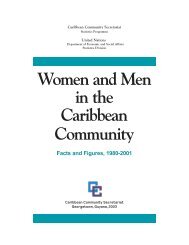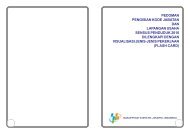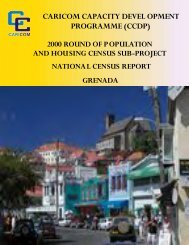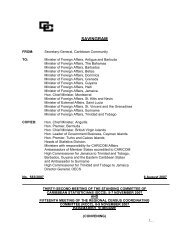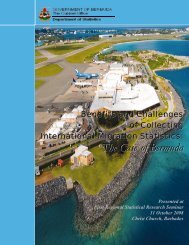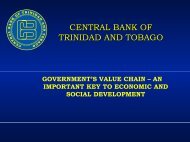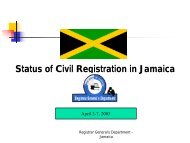CARICOM CAPACITY DEVELOPMENT PROGRAMME (CCDP)
CARICOM CAPACITY DEVELOPMENT PROGRAMME (CCDP)
CARICOM CAPACITY DEVELOPMENT PROGRAMME (CCDP)
You also want an ePaper? Increase the reach of your titles
YUMPU automatically turns print PDFs into web optimized ePapers that Google loves.
National Census Report 2001, St. Vincent and the GrenadinesWhen only those persons that are employed are factored into the equation to give a moreaccurate picture of the economic dependency of children, the ratio is higher. The data revealedthat there were 93 children for every 100 persons in the working age population that had a job.This child worker ratio is almost twice as high as the child dependency ratio.North and South Grenadines (59) had the lowest child worker ratio and Chateaubelair (134) hadthe highest. In addition to Chateaubelair, there were six other administrative divisions that hadmore children than workers including, Sandy Bay (127), Georgetown (124) and Barrouallie(119). This means that the burden of health care, education, and other children’s needs is evenhigher in these communities than in the others.8.7 Children with Disability or InfirmityThere were 538 reported cases or 1.65 per cent of children with disability or infirmity. SandyBay (2.63), Colonarie and North Grenadines (2.44) had the highest proportion of children thatreported disability or infirmity, while Barrouallie (1.09) had the lowest (Table 8.6).The number and percentage of reported cases were higher among boys (301 or 1.83 per cent)compared to girls (237 or 1.48 per cent). The percentage of boys that had a disability or infirmitywas highest in Sandy Bay (2.83), Marriaqua (2.68), Colonarie and North Grenadines (2.64)while, Barrouallie had the lowest percentage (1.09). Sandy Bay also had the highest proportion(2.39) of girls with disability or infirmity, followed by Colonarie (2.24) and North Grenadine(2.24). Kingstown Suburb had a lowest rate among girls.Children in the 0 to 4 age group accounted for the smallest share (13.56 per cent) of reporteddisability or illness, while the older children in the 5 to 9 and 10 to 14 years age groupsaccounted for 42.19 and 44.30 per cent, respectively. The distribution by age group was similarfor boys and girls.110



